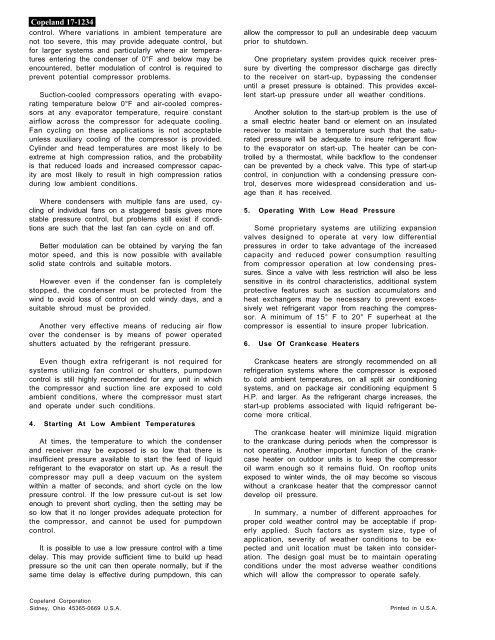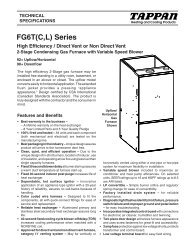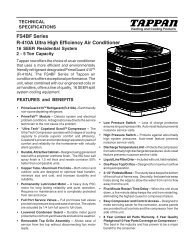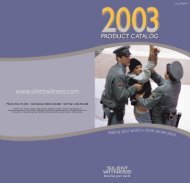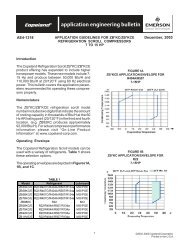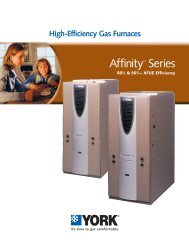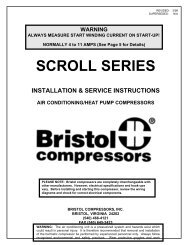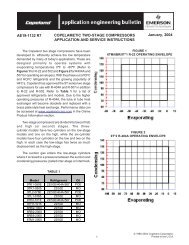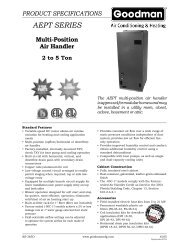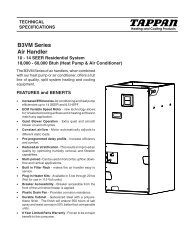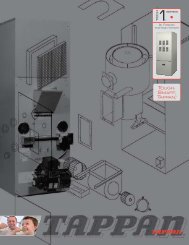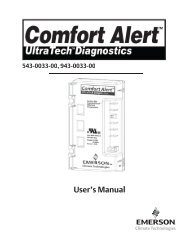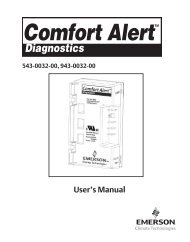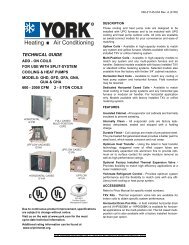Low Ambient Compressor Operation Copeland - Desco Energy
Low Ambient Compressor Operation Copeland - Desco Energy
Low Ambient Compressor Operation Copeland - Desco Energy
Create successful ePaper yourself
Turn your PDF publications into a flip-book with our unique Google optimized e-Paper software.
<strong>Copeland</strong> 21-1222 17-1234<br />
control. Where variations in ambient temperature are<br />
not too severe, this may provide adequate control, but<br />
for larger systems and particularly where air temperatures<br />
entering the condenser of 0°F and below may be<br />
encountered, better modulation of control is required to<br />
prevent potential compressor problems.<br />
Suction-cooled compressors operating with evaporating<br />
temperature below 0°F and air-cooled compressors<br />
at any evaporator temperature, require constant<br />
airflow across the compressor for adequate cooling.<br />
Fan cycling on these applications is not acceptable<br />
unless auxiliary cooling of the compressor is provided.<br />
Cylinder and head temperatures are most likely to be<br />
extreme at high compression ratios, and the probability<br />
is that reduced loads and increased compressor capacity<br />
are most likely to result in high compression ratios<br />
during low ambient conditions.<br />
Where condensers with multiple fans are used, cycling<br />
of individual fans on a staggered basis gives more<br />
stable pressure control, but problems still exist if conditions<br />
are such that the last fan can cycle on and off.<br />
Better modulation can be obtained by varying the fan<br />
motor speed, and this is now possible with available<br />
solid state controls and suitable motors.<br />
However even if the condenser fan is completely<br />
stopped, the condenser must be protected from the<br />
wind to avoid loss of control on cold windy days, and a<br />
suitable shroud must be provided.<br />
Another very effective means of reducing air flow<br />
over the condenser is by means of power operated<br />
shutters actuated by the refrigerant pressure.<br />
Even though extra refrigerant is not required for<br />
systems utilizing fan control or shutters, pumpdown<br />
control is still highly recommended for any unit in which<br />
the compressor and suction line are exposed to cold<br />
ambient conditions, where the compressor must start<br />
and operate under such conditions.<br />
4. Starting At <strong>Low</strong> <strong>Ambient</strong> Temperatures<br />
At times, the temperature to which the condenser<br />
and receiver may be exposed is so low that there is<br />
insufficient pressure available to start the feed of liquid<br />
refrigerant to the evaporator on start up. As a result the<br />
compressor may pull a deep vacuum on the system<br />
within a matter of seconds, and short cycle on the low<br />
pressure control. If the low pressure cut-out is set low<br />
enough to prevent short cycling, then the setting may be<br />
so low that it no longer provides adequate protection for<br />
the compressor, and cannot be used for pumpdown<br />
control.<br />
It is possible to use a low pressure control with a time<br />
delay. This may provide sufficient time to build up head<br />
pressure so the unit can then operate normally, but if the<br />
same time delay is effective during pumpdown, this can<br />
allow the compressor to pull an undesirable deep vacuum<br />
prior to shutdown.<br />
One proprietary system provides quick receiver pressure<br />
by diverting the compressor discharge gas directly<br />
to the receiver on start-up, bypassing the condenser<br />
until a preset pressure is obtained. This provides excellent<br />
start-up pressure under all weather conditions.<br />
Another solution to the start-up problem is the use of<br />
a small electric heater band or element on an insulated<br />
receiver to maintain a temperature such that the saturated<br />
pressure will be adequate to insure refrigerant flow<br />
to the evaporator on start-up. The heater can be controlled<br />
by a thermostat, while backflow to the condenser<br />
can be prevented by a check valve. This type of start-up<br />
control, in conjunction with a condensing pressure control,<br />
deserves more widespread consideration and usage<br />
than it has received.<br />
5. Operating With <strong>Low</strong> Head Pressure<br />
Some proprietary systems are utilizing expansion<br />
valves designed to operate at very low differential<br />
pressures in order to take advantage of the increased<br />
capacity and reduced power consumption resulting<br />
from compressor operation at low condensing pressures.<br />
Since a valve with less restriction will also be less<br />
sensitive in its control characteristics, additional system<br />
protective features such as suction accumulators and<br />
heat exchangers may be necessary to prevent excessively<br />
wet refrigerant vapor from reaching the compressor.<br />
A minimum of 15° F to 20° F superheat at the<br />
compressor is essential to insure proper lubrication.<br />
6. Use Of Crankcase Heaters<br />
Crankcase heaters are strongly recommended on all<br />
refrigeration systems where the compressor is exposed<br />
to cold ambient temperatures, on all split air conditioning<br />
systems, and on package air conditioning equipment 5<br />
H.P. and larger. As the refrigerant charge increases, the<br />
start-up problems associated with liquid refrigerant become<br />
more critical.<br />
The crankcase heater will minimize liquid migration<br />
to the crankcase during periods when the compressor is<br />
not operating. Another important function of the crankcase<br />
heater on outdoor units is to keep the compressor<br />
oil warm enough so it remains fluid. On rooftop units<br />
exposed to winter winds, the oil may become so viscous<br />
without a crankcase heater that the compressor cannot<br />
develop oil pressure.<br />
In summary, a number of different approaches for<br />
proper cold weather control may be acceptable if properly<br />
applied. Such factors as system size, type of<br />
application, severity of weather conditions to be expected<br />
and unit location must be taken into consideration.<br />
The design goal must be to maintain operating<br />
conditions under the most adverse weather conditions<br />
which will allow the compressor to operate safely.<br />
<strong>Copeland</strong> Corporation<br />
Sidney, Ohio 45365-0669 U.S.A.<br />
Printed in U.S.A.


